
AMD Ryzen 7 1700 vs. a 5-year-old gaming PC, or why you should never preorder
 Image: Brad Chacos
Image: Brad Chacos
I, like many of you, have been waiting for AMD’s Ryzen processors.
Sure, as PCWorld’s gaming and graphics-card editor, I test new hardware with our lab’s powerful GPU test system fairly often. But as regular viewers of our bi-weekly Full Nerd podcast already know, my personal system—the one I do most of my gaming on—still rocks an Intel Core i5-3570K. There’s a fine reason for that: The venerable Ivy Bridge chip still holds up spectacularly in most games, even at 4K resolution, and the latest generations of Intel chips haven’t exactly blown off the barn doors in terms of performance.
That said, my beloved companion is coming up on its fifth birthday and is starting to show its age. While performance remains top-notch in most titles, the 3570K can chug a bit in some titles, especially when I’m playing massive open-world games. The platform itself hurts more, though—my half-decade-old system can’t partake in gloriously fast newer technologies like NVMe SSDs, USB 3.1 ports, and Thunderbolt connections. I have a need—a need for speed. It’s time to upgrade.
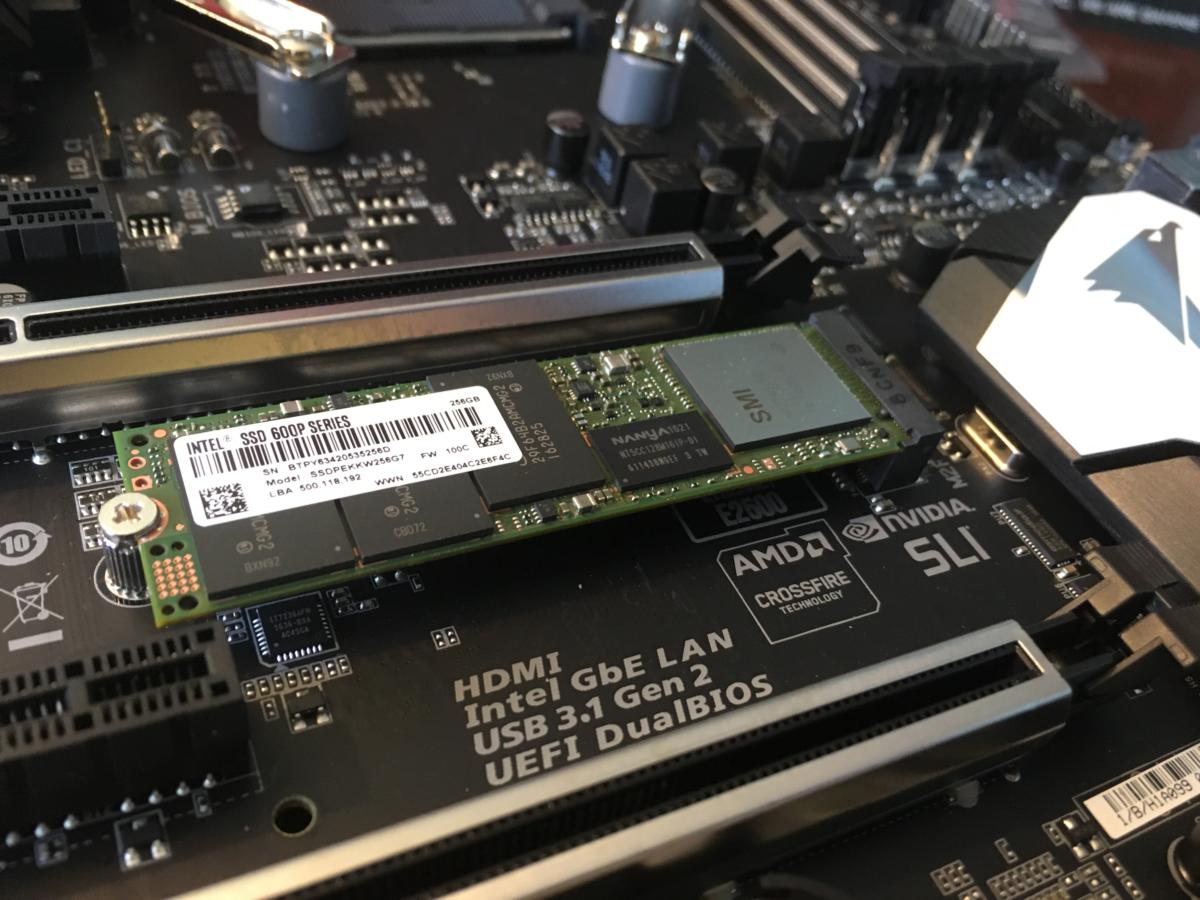 Brad Chacos
Brad ChacosM.2 NVMe SSDs are a no-go in my aging 3570K PC.
So I’ve been waiting for Ryzen. Not necessarily to buy Ryzen, but to see what it brings to the table, compare it to Intel’s Kaby Lake and Broadwell-E parts, and make an informed decision. I practice what I preach!
But I’m also a selfish creature. While Gordon Ung’s been toiling away at PCWorld’s comprehensive Ryzen review, benchmarking the new chips against their FX predecessors and Intel’s latest and greatest, I decided to some quick real-world tests. I paired the Ryzen 7 1800X with the Radeon Fury X to create the liquid-cooled, fire-breathing pinnacle of AMD PC performance. The result was a rig that hung damned well with a pricey Core i7-5960X-based rig at 4K and 1440p resolutions.
But can AMD’s more modestly priced Ryzen 7 1700 provide a no-brainer upgrade over my aging, but still potent gaming PC at more common game settings? Spoiler: Nope, it can’t—though the complete answer is more complicated than that.
Let’s dig in.
Watch PCWorld’s Full Nerd crew talk about these results, general Ryzen performance, and YOUR questions about AMD’s new chip in the video below.
Ryzen PC vs. 3570K PC tech specs
To put my basic question to the test, I built a rig with the 3.7GHz Ryzen 7 1700 ($330 on Amazon) and the stock 8GB Radeon RX 480 ($215 on Amazon). The goal was to see how the duo handles gaming at more mainstream 1080p and 2560×1440 resolutions.
The 8-core, 16-thread Ryzen 7 1700 costs less than an Intel Core i7-7700K ($340 on Amazon) while packing twice as many cores and threads. The Radeon RX 480, meanwhile, is the best “sweet spot” graphics card you can buy and a superb option for the resolutions I wanted to test. The Ryzen 7 1700/RX 480 combo defines the AMD-based PC that many gamers are likely to buy at Ryzen’s launch.
Mentioned in this article
AMD Ryzen 7 1700 Processor with Wraith Spire LED Cooler
 Price When Reviewed:$329.00Best Prices Today:$195 at Amazon
Price When Reviewed:$329.00Best Prices Today:$195 at Amazon
The rest of the rig’s components mirrored the parts in my ultimate AMD machine; only the CPU and GPU were swapped out. It included the EKWB XLC Predator 240 closed-loop liquid cooler; Gigabyte’s Aorus AX370-Gaming 5 motherboard ($195 on Amazon); 16GB (2 x 8GB) of Corsair’s 3000MHz Vengeance LPX low-profile DDR4 RAM ($110 on Amazon); a single 256GB Intel SSD 600p Series M.2 NVMe SSD ($100 on Newegg); Corsair’s AX1200i power supply with 80 PLUS platinum efficiency ($310 on Amazon); and Corsair’s tiny Carbide 400C case ($100 on Amazon).
Software-wise, the Ryzen 7 1700 PC is running a fresh Windows 10 ($120 on Amazon) installation, as that’s required to run the DirectX 12 games that AMD’s touting with Ryzen chips and Radeon processors. I manually changed the operating system’s power settings to High Performance from the default Balanced, as AMD says that gives the Ryzen chip’s features more direct control over performance. Here’s hoping that AMD can communicate that to actual buyers of the chip!
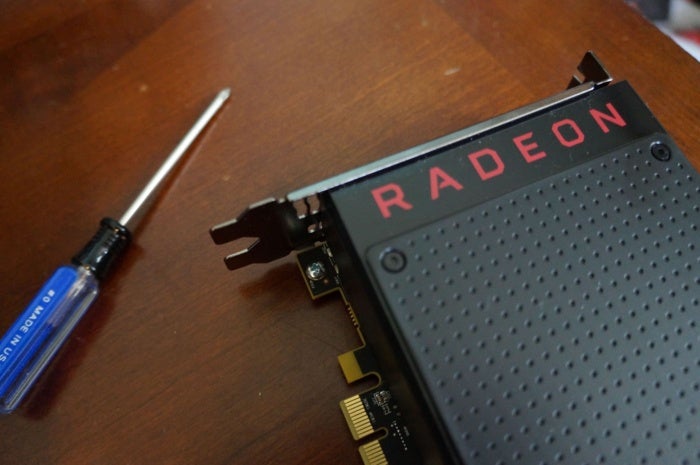 Brad Chacos
Brad ChacosThe reference 8GB Radeon RX 480.
My personal PC has none of the same parts, since this isn’t a highly controlled apples-to-apples test. It’s a comparative real-world test to see how an older gaming rig performs against this modern counterpart. That said, I swapped in the same 8GB Radeon RX 480 to keep graphics performance consistent, and relevant to mainstream PC gamers. (My graphics card is normally a GeForce GTX 1080.)
Mentioned in this article
Radeon RX 480 (8GB)
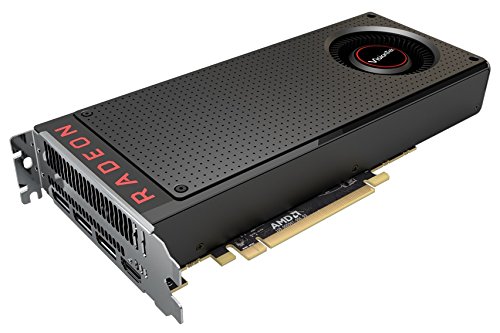 Read our reviewPrice When Reviewed:$240
Read our reviewPrice When Reviewed:$240
The Core i5-3570K was long ago overclocked from its stock 3.5GHz to 4.2GHz to put more pep in its step. Because gamers with similar rigs are likely to have done the same, I left that in place. (Remember: Real-world comparison between two systems! Should I upgrade?) As an i5 part, it only has four physical cores with one thread each, so it’s significantly less multithreaded than the 16-thread Ryzen chip.
Other hardware includes a modestly priced Gigabyte gaming motherboard of unremembered make and model, 16GB of DDR3—not DDR4—G.Skill RAM clocked at 2133MHz, and Cooler Master’s beloved Hyper Master 212 CPU cooler. Windows 10 and all tested games are installed on one of the first-ever 500GB SSDs, an OCZ Agility model that’s downright pokey compared to modern SSDs.
Enough chit-chat. Let’s take this to the test bench!
Next page: Performance results and thoughts
Performance results
While I was pleasantly surprised by the ultimate AMD machine’s performance, the more mainstream Ryzen 7 1700 build left a bitter taste in my mouth. I wasn’t expecting it to blow Intel’s 3570K out of the water, but I was hoping for some sort of performance pick-me-up, or at least parity. Instead, Intel’s quad-core, 5-year-old chip smoked Ryzen in two out of the three games tested—and I mean smoked—and the CPUs traded blows in the third.
Wow.
First up: The Division. Testing was conducted using the Ultra graphics preset, with V-Sync and any GPU vendor-specific technologies disabled, as usual. The results aren’t pretty for the Ryzen 7 1700. Heck, at 1080p it’s a damned massacre.
 Brad Chacos
Brad ChacosIt doesn’t get any better in Far Cry Primal at the Ultra graphics preset.
On the bright side, the Ryzen/Radeon combo does manage to squeak past 60 frames per second at 1080p in both The Division and Far Cry, so it’s definitely not providing a bad gaming experience.
 Brad Chacos
Brad ChacosThings get more interesting in Ashes of the Singularity at High graphics settings, using the more conventional GPU focused test (as Gordon hammered the CPU test in his review). Ashes is an AMD-supported game that’s the poster child for superb DirectX 12 implementations, and its GPU test is a staple in PCWorld’s graphics card benchmarking suite.
 Brad Chacos
Brad Chacos Brad Chacos
Brad ChacosThe quad-core Intel chip snags a slight lead over the Ryzen 7 1700 when using DirectX 11, but the tables flip in DX12, where AMD’s processor gets out in front of Intel’s chip by a decent margin, likely due to its additional cores and threads. Ashes will use as many threads as you throw at it, which is why I made sure to include it in my brief trio of tests.
 Brad Chacos
Brad ChacosOne area where the Ryzen 7 1700 clearly wins is power efficiency, despite packing twice the cores and quadruple the threads of the 3570K. Chip efficiency has come a long way over the past five years. Pairing that efficiency with the beastly EKWB Predator cooler worked wonders, as well, as AMD’s chip stayed at a ridiculously chilly 28 degrees Celsius throughout testing. That’s damned impressive.
Three games isn’t a comprehensive test whatsoever (cursed time constraints!), but Gordon saw lackluster gaming results on Ryzen PCs in PCWorld’s exhaustive Ryzen review, using more apples-to-apples testing configurations with CPU-bound settings. Several reviewers from other publications have told me they’ve seen similar results as well. The performance gap closes mightily if you scale up your display resolution and firepower of the graphics card due to the bottleneck shifting from the CPU to the GPU. That’s evidenced in my ultimate AMD rig build guide with these same three games. But the majority of PC gamers play at 1080p or lower resolutions, according to the Steam hardware survey.
Ugh.
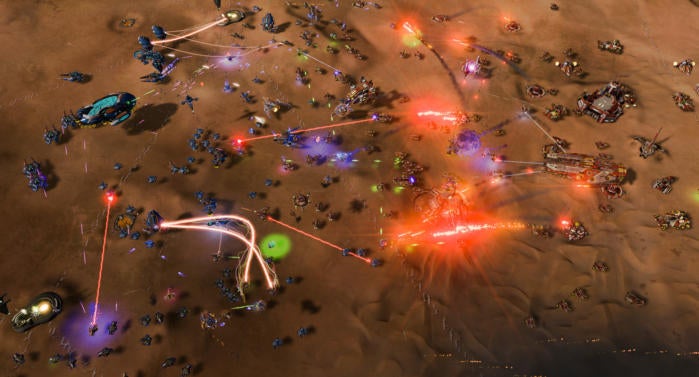 Ashes of the Singularity
Ashes of the SingularityThe Ryzen 7 1700’s abundant cores and threads give it an edge in Ashes of the Singularity.
Don’t get me wrong: There’s a whole lot to like about Ryzen. Like I said, it’s competitive at higher gaming resolutions, or if you pair it with a top-end graphics card like the GTX 1080. As evidenced by the Jekyll and Hyde Ashes of the Singularity results, Ryzen shines in games that actually make use of abundant cores, which is encouraging indeed if DirectX 12 and Vulkan games start gaining traction. Ryzen’s incredibly, impressively power-efficient. The platform supports every modern amenity you could ask for. And, as you’ll discover in PCWorld’s Ryzen review, AMD’s CPUs actually whomp Intel’s chips in multithreaded productivity tasks—and for a fraction of the price of comparable 8-core Core processors. The Ryzen 7 1700 is damned disruptive, and not a dud whatsoever.
No, it’s not a dud—unless you’re looking to replace a 5-year-old, quad-core Intel Core i5 chip for mainstream gaming at the most popular display resolution. There, the Ryzen 7 1700 can stumble, and stumble hard.
When asked about Gordon’s middling CPU performance results in 1080p games (not my results specifically), AMD corporate vice president John Taylor blamed the gap on games being optimized on Intel processors.
“CPU benchmarking deficits to the competition in certain games at 1080p resolution can be attributed to the development and optimization of the game uniquely to Intel platforms–until now. Even without optimizations in place, Ryzen delivers high, smooth frame rates on all “CPU-bound” games, as well as overall smooth frame rates and great experiences in GPU-bound gaming and VR. With developers taking advantage of Ryzen architecture and the extra cores and threads, we expect benchmarks to only get better, and enable Ryzen excel at next generation gaming experiences as well. Game performance will be optimized for Ryzen and continue to improve from at-launch frame rate scores.”
We can’t do much beyond take AMD’s word here, but the company is trying to correct the problem. It provided statements from Stardock, maker of Ashes of the Singularity, and Total War: Warhammer’s Creative Assembly saying that they’re working closely with AMD to optimize for Ryzen, and seeing encouraging early results.
What’s more, AMD says it’s seeded 300-plus Ryzen kits to game developers, and plans to ship over 1,000 total by the end of the year. And at GDC, the company announced an unprecedented multi-game, multi-series technical partnership with Bethesda—maker of Doom, Fallout, The Elder Scrolls, Prey, Dishonored, and more—to implement Vulkan and AMD optimizations in more Bethesda games after Doom’s spectacular success.
Why preordering sucks
This is the problem with preordering, folks.
AMD put its pricey Ryzen 7 processors up for preorder long before professional reviewers laid hands on the chips. Excited PC enthusiasts bought them like hotcakes, eager to see AMD return with a high-end CPU—but all of Ryzen’s performance promises stemmed from AMD marketing and canned tests designed to show the processors in the best light possible. As it turns out, Ryzen is competitive, and highly so in many tasks. But not universally. Ryzen’s performance story and value proposition is complicated.
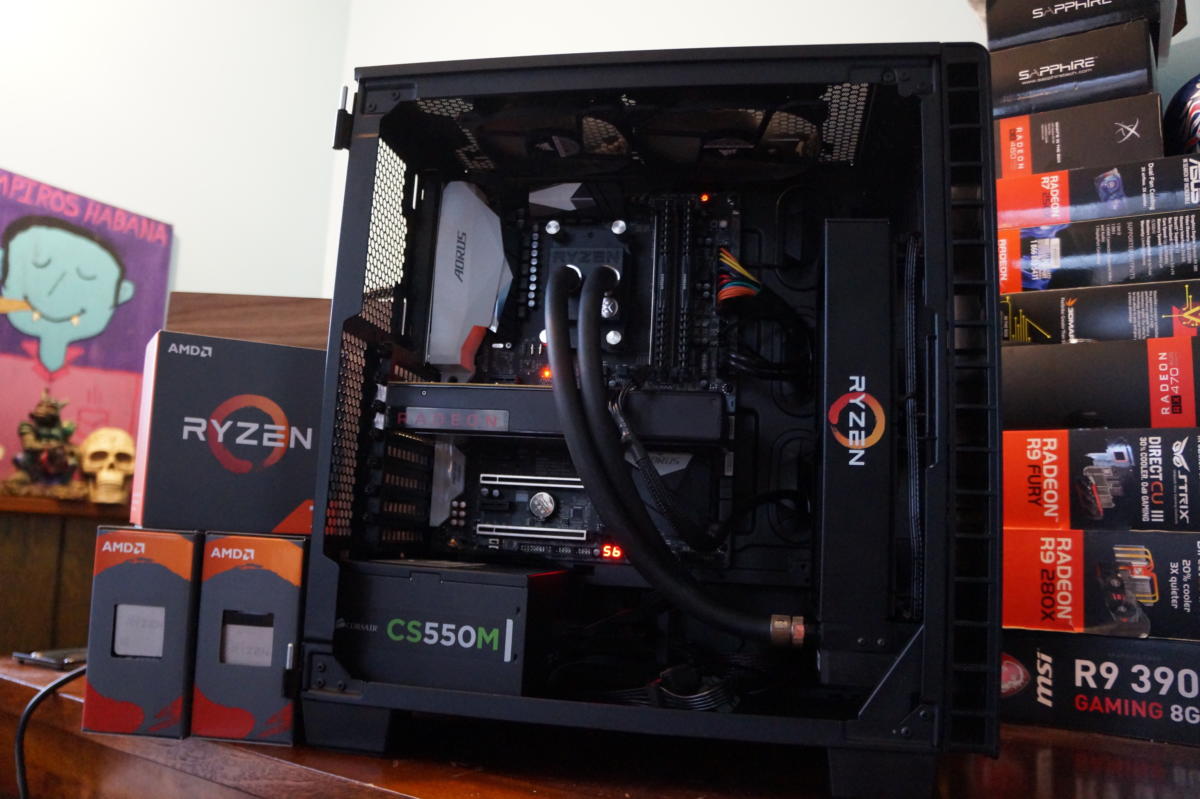 Brad Chacos
Brad ChacosGreat for many things, but not 1080p gaming.
That wasn’t apparent until today, when independent reviews lifted concurrent with Ryzen’s street launch. People who preordered Ryzen 7 CPUs to replace an aging gaming PC—like the venerable Core i5-2600K and 3570K parts so many gamers still cling to, myself included—may have very well purchased a $300-plus processor that actually delivers equal or significantly worse performance in some common gaming scenarios. Ryzen’s kick-ass multithreaded productivity chops don’t matter if you mostly use your PC to hunt rogue agents in The Division’s Dark Zone at 1080p.
That’s why you wait for reviews, be it from PCWorld, other publications, your favorite YouTubers or Reddit communities, whatever. Preordering games and getting broken messes like Batman: Arkham Knight or Assassin’s Creed: Unity is frustrating enough. But it’s so much worse if the multi-hundred-dollar heart of your PC disappoints in the tasks you primarily use your PC for.
As for me, I’m not ruling out Ryzen yet in my quest to move to a modern platform. 1080p ain’t for me. I play PC games with a GTX 1080 at 4K or 1440p resolution, where most games are GPU-limited and Ryzen competes fiercely with Intel’s Extreme Edition parts. Plus, I plan to start dabbling in streaming soon, as well as creating videos for work, so all those cores and Ryzen’s multithreaded power in productivity tasks may be just what I’m looking for—especially when compared to the $1,050 price of Intel’s 8-core parts.
But I sure am glad I waited for Ryzen reviews before spending my hard-earned cash.